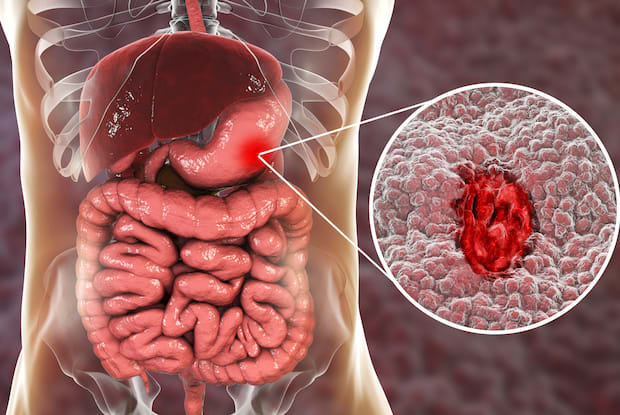Table of Contents
II. Pantoprazole for Acid Reflux and GERD
III. Pantoprazole for Zollinger-Ellison Syndrome
a. What is Zollinger-Ellison Syndrome?
b. How is Zollinger-Ellison Syndrome Treated?
IV. Pantoprazole for Stomach Ulcers
b. How Are Stomach Ulcers Treated?
What is Pantoprazole?
Many people have stomach problems from time to time. Common problems can include indigestion and heartburn. Pantoprazole is a proton pump inhibitor (PPI) drug that is used to treat several medical conditions that involve stomach acid. Pantoprazole is also known by the brand name Protonix and internationally is known as Pantpas.
Pantoprazole is commonly prescribed to treat heartburn, gastroesophageal reflux disease (GERD), Zollinger-Ellison syndrome, and stomach ulcers, as well as other conditions. Keep reading to learn more about these conditions and how they can be treated with pantoprazole.
Pantoprazole for Acid Reflux and GERD
a. What is Acid Reflux?
Acid reflux is a very common condition and occurs when stomach acid flows backward into the esophagus, the tube that connects the throat and the stomach. One of the most common results of acid reflux is heartburn. Research shows that more than 60 million people in the United States experience heartburn at least once a month. Around 15 million Americans may experience heartburn daily. [1]
Heartburn causes a burning sensation in the esophagus, behind the breast bone. Contrary to its common name, heartburn is not caused by, or affect, the heart. The sensation of heartburn can last for hours and maybe worsened by eating, bending over, or lying down. In some cases, stomach acid may flow all the way up the esophagus towards the throat area. This can cause a sour taste in the back of your mouth. Stomach acid is a powerful chemical produced to digest proteins. Stomach acid is also known as gastric juice and can be very potent. As it burns, it is contained to the stomach, which can resist its potency. The valve that connects the esophagus and the stomach is usually closed but opens as you eat to allow food to enter the stomach. However, this can occasionally malfunction if it doesn’t close or tighten correctly. This can allow both food and stomach acid to flow backward into the esophagus, causing acid reflux. [2] Many people suffer from occasional acid reflux. However, if it occurs more than once a week, or you suffer from severe acid reflux once a week, then gastroesophageal reflux disease (GERD) may be diagnosed. [3] Heartburn is not the only symptom of GERD. Other common symptoms can include problems swallowing, chest pain, dry cough, asthma symptoms, regurgitation of food, or a lump in your throat. [4] There are several factors that can increase the risk of developing gastroesophageal reflux disease. These include: In addition to these, there are other variables that can worsen the condition. Smoking, certain medications, and certain foods and drinks may increase the severity of your condition. Common triggers can include fatty foods, fried foods, alcohol, coffee, particularly large meals, or eating late at night. [4] GERD is typically treated using medications and by altering eating habits. For mild GERD, over-the-counter antacids, H2 receptor blockers, or proton pump inhibitor (PPI) drugs may be effective. For more serious conditions, your doctor may prescribe other medications. One of the most common prescription medications to treat GERD is pantoprazole (Protonix). Pantoprazole is a PPI and works to treat GERD by decreasing the amount of acid that the stomach produces, which allows the esophagus to heal. [6] Zollinger-Ellison syndrome (ZES) is a condition that results in tumors forming in the pancreas or small intestine. These tumors then produce excess amounts of the hormone gastrin. This excess hormone results in the stomach creating more stomach acid, which can cause a wide range of symptoms. [7] It is a rare condition and affects around one in every million people. ZES can affect anyone but it is most common in men between 30 and 50. [8] Zollinger-Ellison syndrome can cause many symptoms. Common symptoms include: Zollinger-Ellison syndrome is typically treated by lowering levels of acid produced by the stomach. Doctors will usually prescribe a proton pump inhibitor medication such as pantoprazole to achieve this. Pantoprazole works to reduce stomach acid by inhibiting small ‘pumps’ found inside the acid-producing stomach cells. Approximately 10 percent of people living in Western countries will suffer an ulcer in their stomach or small intestines during their life. [9] Stomach ulcers are also known as gastric ulcers and can be very painful. Gastric ulcers can cause serious problems if they are not treated promptly. Your stomach has a layer of mucus that protects it from the stomach acid that digests food. Stomach ulcers occur when this protective lining is worn away and no longer functions correctly. When this happens, the acid in the stomach damages the tissue in the stomach, resulting in an ulcer. [9] Stomach ulcers usually occur when the amount of mucus in the stomach is reduced, or the amount of stomach acid is increased. There are several factors that can cause this to happen. These include a specific form of bacteria (H. pylori), certain medications, particularly pain-relievers, and very occasionally Zollinger-Ellison Syndrome. [10] The most common symptom of a stomach ulcer is a burning pain felt between the chest and the belly button. This pain may last between a few minutes and many hours and is likely to be more painful when you have an empty stomach. Other symptoms of a stomach ulcer include: The treatment for stomach ulcers depends on its cause. When the ulcer is caused by bacteria, then the most beneficial treatment will be an antibiotic to treat the infection. For other causes of stomach ulcers, it is likely that your doctor will prescribe a PPI drug such as pantoprazole (Protonix). Pantoprazole treats stomach ulcers by reducing the amount of stomach acid that is produced. Sometimes doctors may prescribe both an antibiotic and a PPI together to treat the condition. Other medications used to treat stomach ulcers may include acid-blockers and antacids. The content in this article is intended for informational purposes only. This website does not provide medical advice. In all circumstances, you should always seek the advice of your physician and/or other qualified health professionals(s) for drug, medical condition, or treatment advice. The content provided on this website is not a substitute for professional medical advice, diagnosis, or treatment.
b. What is GERD?
c. How is GERD Treated?

Pantoprazole for Zollinger-Ellison Syndrome
a. What is Zollinger-Ellison Syndrome?
b. How is Zollinger-Ellison Syndrome Treated?
Pantoprazole for Stomach Ulcers
a. What are Stomach Ulcers?

b. How Are Stomach Ulcers Treated?
